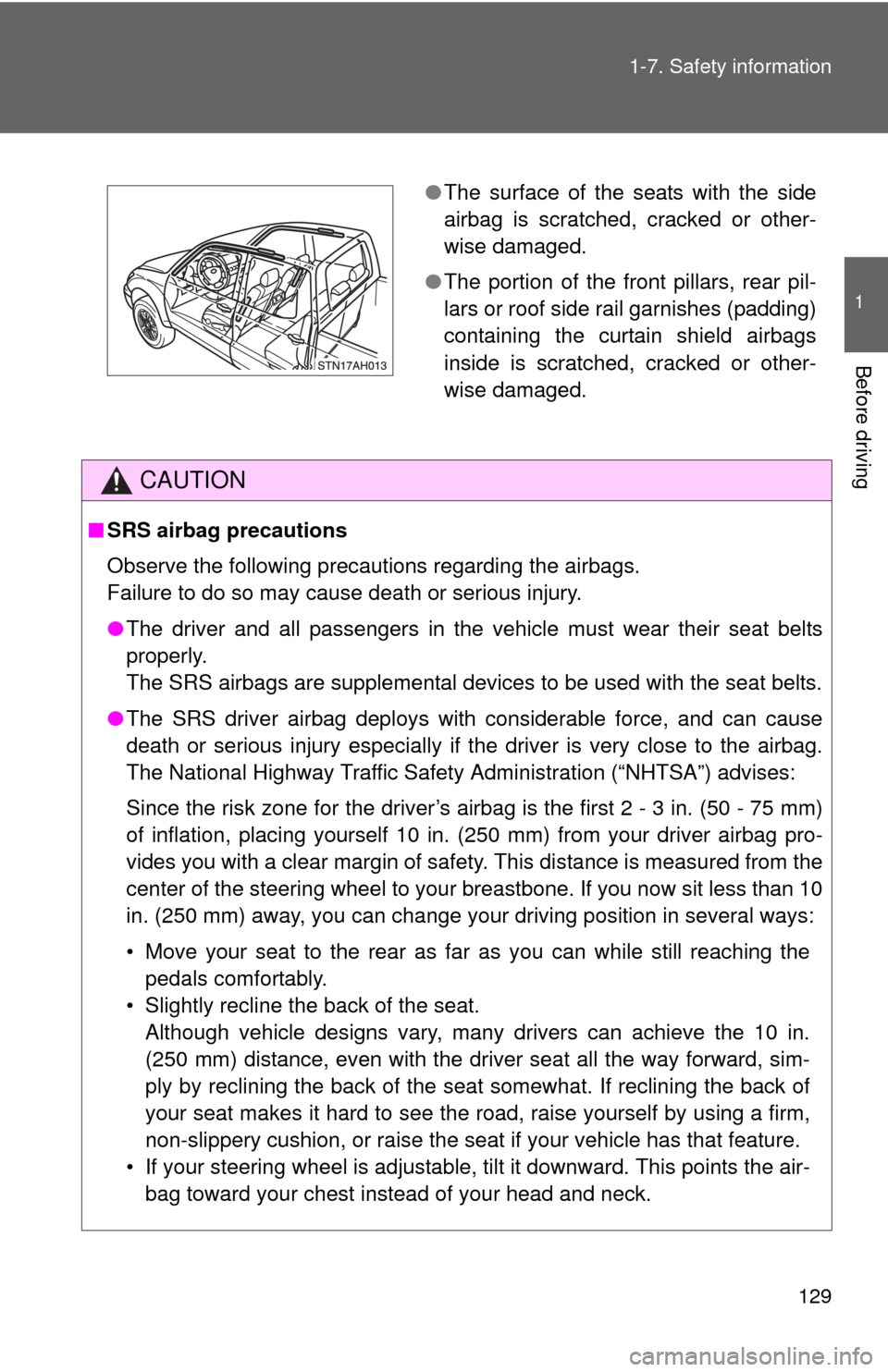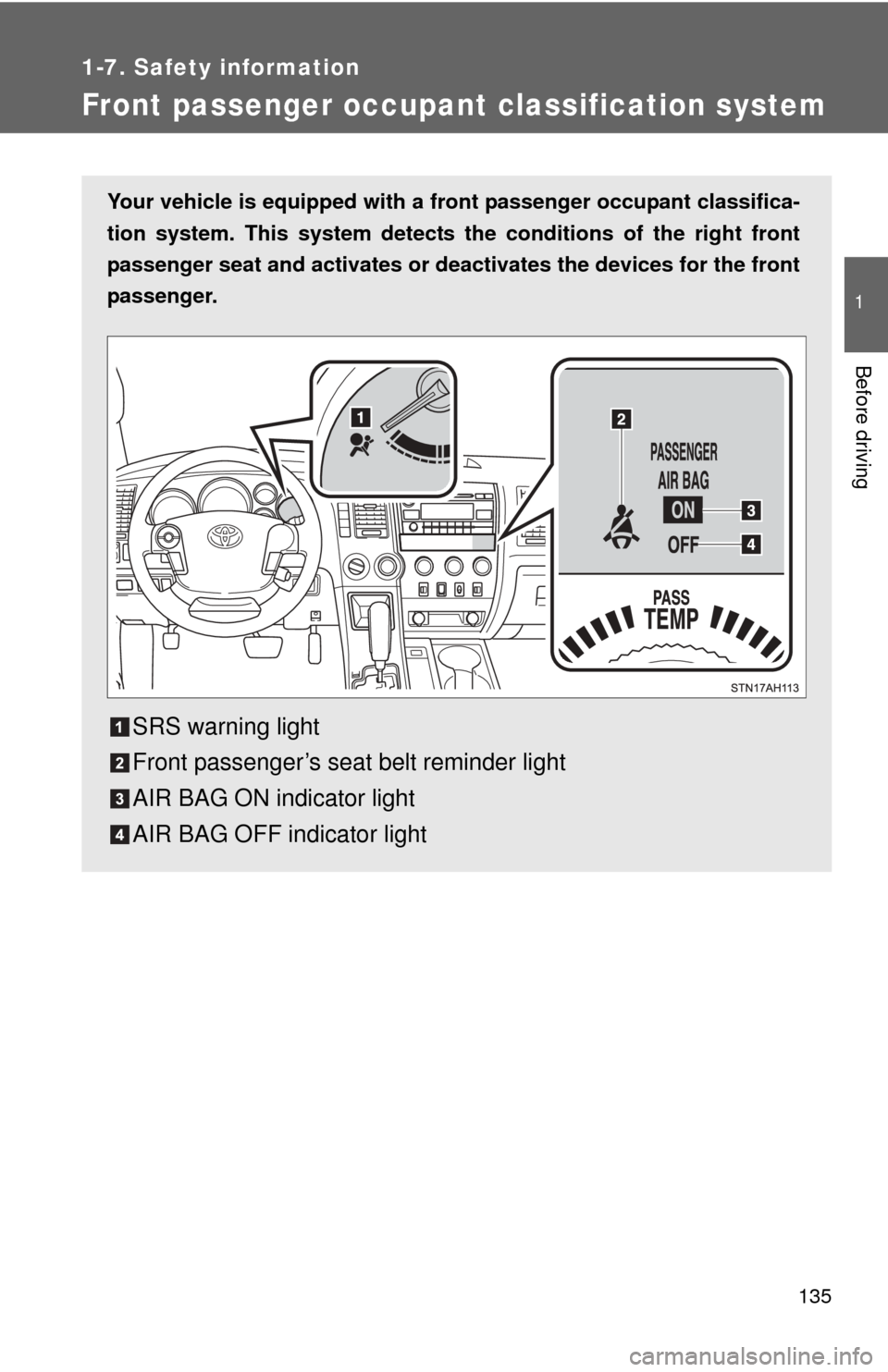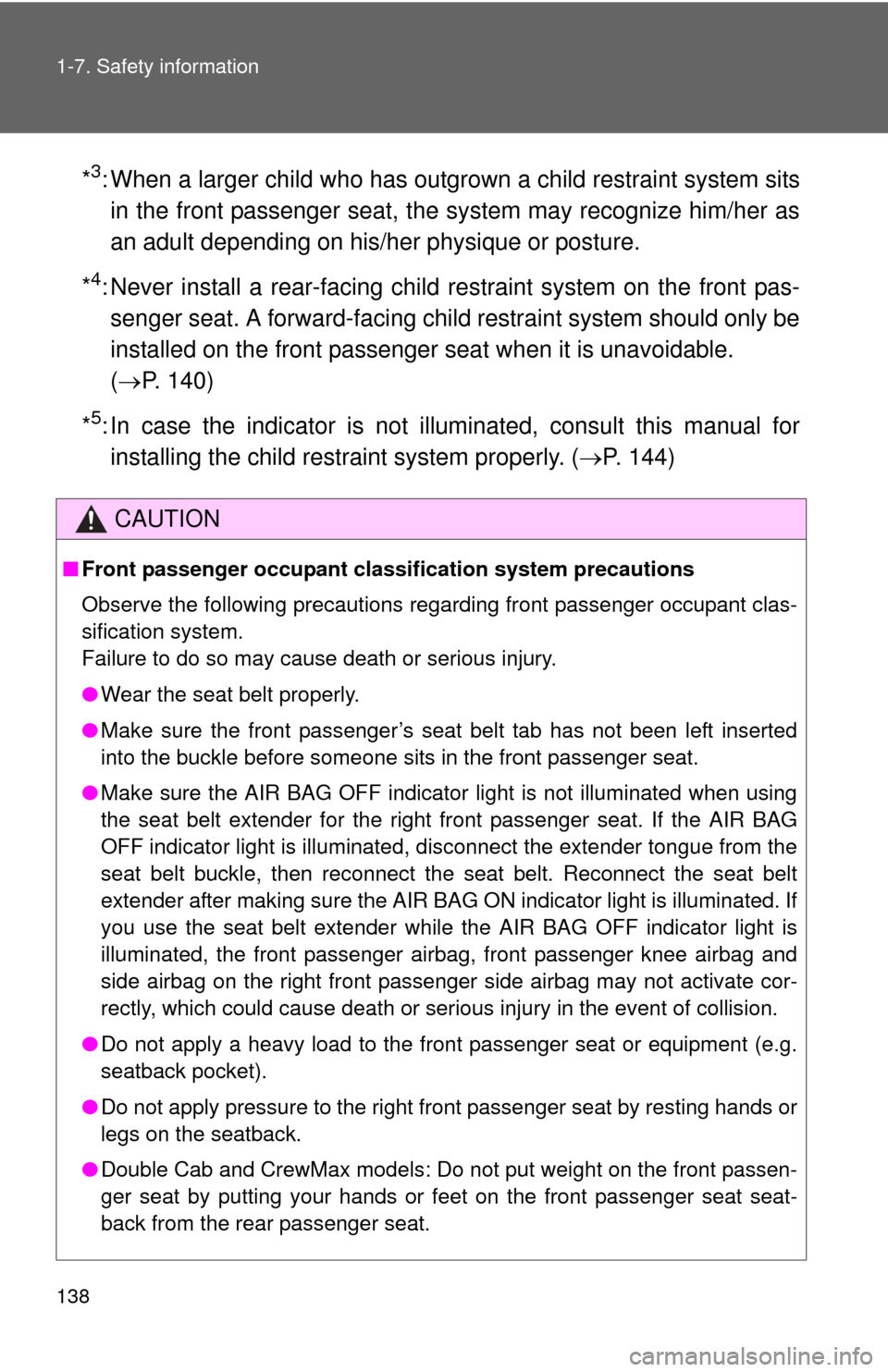2012 TOYOTA TUNDRA light
[x] Cancel search: lightPage 125 of 744

125
1-7. Safety information
1
Before driving
■
SRS warning light
This warning light system monitors the airbag sensor assembly, front airbag
sensors, side and curtain shield airbag sensor assemblies, curtain shield air-
bag sensor assemblies, driver’s seat position sensor, driver’s seat belt
buckle switch, front passenger occupant classification system, AIR BAG ON
and AIR BAG OFF indicator lights, front passenger’s seat belt buckle switch,
front seat belt pretensioner assemblies , RSCA OFF indicator light, inflators,
interconnecting wiring and power sources. ( P. 610)
■ If the SRS airbags deploy (inflate)
●Bruising and slight abrasions may result from contact with a deploying
(inflating) SRS airbag.
● A loud noise and white powder will be emitted.
● Parts of the airbag module (steering wheel hub, airbag cover and inflator)
as well as the front seats, and parts of the front and rear pillars and roof
side rail, may be hot for several minutes. The airbag itself may also be
hot.
● The front windshield may crack.
■ Operating conditions (front airbags)
●The SRS front airbag will deploy in the event of an impact that exceeds
the set threshold level (the level of force corresponding to an approxi-
mately 12-18 mph [20-30 km/h] frontal collision with a fixed wall that does
not move or deform).
However, this threshold velocity will be considerably higher if the vehicle
strikes an object, such as a parked vehicle or sign pole, which can move or
deform on impact, or if the vehicle is involved in an underride collision (e.g.
a collision in which the front of the vehicle “underrides”, or goes under, the
bed of a truck, etc.).
● It is possible that in some collisions where the forward deceleration of the
vehicle is very close to the designed threshold level, the SRS front air-
bags and the seat belt pretensioners may not activate together.
● The SRS front passenger airbag will not activate if there is no passenger
sitting in the right front passenger seat. However, the front passenger air-
bag may deploy if luggage is put in the seat, or the seat belt is fastened,
even if the seat is unoccupied. ( P. 135)
Page 129 of 744

129
1-7. Safety information
1
Before driving
CAUTION
■
SRS airbag precautions
Observe the following precautions regarding the airbags.
Failure to do so may cause death or serious injury.
●The driver and all passengers in the vehicle must wear their seat belts
properly.
The SRS airbags are supplemental devices to be used with the seat belts.
● The SRS driver airbag deploys with considerable force, and can cause
death or serious injury especially if the driver is very close to the airbag.
The National Highway Traffic Safety Administration (“NHTSA”) advises:
Since the risk zone for the driver’s airbag is the first 2 - 3 in. (50 - 75 mm)
of inflation, placing yourself 10 in. (250 mm) from your driver airbag pro-
vides you with a clear margin of safety. This distance is measured from the
center of the steering wheel to your breastbone. If you now sit less than 10
in. (250 mm) away, you can change your driving position in several ways:
• Move your seat to the rear as far as you can while still reaching the
pedals comfortably.
• Slightly recline the back of the seat. Although vehicle designs vary, many drivers can achieve the 10 in.
(250 mm) distance, even with the driver seat all the way forward, sim-
ply by reclining the back of the seat somewhat. If reclining the back of
your seat makes it hard to see the road, raise yourself by using a firm,
non-slippery cushion, or raise the seat if your vehicle has that feature\
.
• If your steering wheel is adjustable, tilt it downward. This points the air- bag toward your chest instead of your head and neck.
● The surface of the seats with the side
airbag is scratched, cracked or other-
wise damaged.
● The portion of the front pillars, rear pil-
lars or roof side rail garnishes (padding)
containing the curtain shield airbags
inside is scratched, cracked or other-
wise damaged.
Page 135 of 744

135
1
1-7. Safety information
Before driving
Front passenger occupant classification system
Your vehicle is equipped with a front passenger occupant classifica-
tion system. This system detects the conditions of the right front
passenger seat and activates or deactivates the devices for the front
passenger.
SRS warning light
Front passenger’s seat belt reminder light
AIR BAG ON indicator light
AIR BAG OFF indicator light
Page 136 of 744

136 1-7. Safety information
Conditions and operation of the front passenger occupant
classification system
■ Adult*
1
■Child*3 or child restraint system*4
Indicator/
warning light AIR BAG ON and AIR BAG OFF indica-
tor lights AIR BAG ON
SRS warning light Off
Front passenger’s seat belt reminder light
Flashing*2
Devices Front passenger airbag
Activated
Front passenger knee airbag
Side airbag on the front passenger seat
Curtain shield airbag in the front passen- ger side
Front passenger’s seat belt pretensioner
Indicator/
warning light AIR BAG ON and AIR BAG OFF indica-
tor lights AIR BAG
OFF*
5
SRS warning light Off
Front passenger’s seat belt reminder light Flashing*
2
DevicesFront passenger airbag
Deactivated
Front passenger knee airbag
Side airbag on the front passenger seat
Activated
Curtain shield airbag in the front passen-
ger side
Front passenger’s seat belt pretensioner
Page 137 of 744

137
1-7. Safety information
1
Before driving
■
Unoccupied
■ There is a malfunction in the system
*
1: The system judges a person of adult size as an adult. When a
smaller adult sits in the front passenger seat, the system may rec-
ognize him/her as a child depending on his/her physique and pos-
ture.
*
2: In the event the front passenger does not wear a seat belt.
Indicator/
warning light AIR BAG ON and AIR BAG OFF indica-
tor lights Not illumi-
nated
SRS warning light Off
Front passenger’s seat belt reminder
light
Devices Front passenger airbag
Deactivated
Front passenger knee airbag
Side airbag on the front passenger seat Activated
Curtain shield airbag in the front passen-
ger side
Front passenger’s seat belt pretensioner Deactivated
Indicator/
warning light AIR BAG ON and AIR BAG OFF indica-
tor lights AIR BAG
OFF
SRS warning light On
Front passenger’s seat belt reminder light Off
Devices Front passenger airbag
Deactivated
Front passenger knee airbag
Side airbag on the front passenger seat
Activated
Curtain shield airbag in the front passen-
ger side
Front passenger’s seat belt pretensioner
Page 138 of 744

138 1-7. Safety information
*3: When a larger child who has outgrown a child restraint system sitsin the front passenger seat, the system may recognize him/her as
an adult depending on his/her physique or posture.
*
4: Never install a rear-facing child restraint system on the front pas-
senger seat. A forward-facing child restraint system should only be
installed on the front passenger seat when it is unavoidable.
( P. 140)
*
5: In case the indicator is not illu minated, consult this manual for
installing the child restraint system properly. ( P. 144)
CAUTION
■Front passenger occupant cl assification system precautions
Observe the following precautions regarding front passenger occupant clas-
sification system.
Failure to do so may cause death or serious injury.
● Wear the seat belt properly.
● Make sure the front passenger’s seat belt tab has not been left inserted
into the buckle before someone sits in the front passenger seat.
● Make sure the AIR BAG OFF indicator light is not illuminated when using
the seat belt extender for the right front passenger seat. If the AIR BAG
OFF indicator light is illuminated, disconnect the extender tongue from the
seat belt buckle, then reconnect the seat belt. Reconnect the seat belt
extender after making sure the AIR BAG ON indicator light is illuminated. If
you use the seat belt extender while the AIR BAG OFF indicator light is
illuminated, the front passenger airbag, front passenger knee airbag and
side airbag on the right front passenger side airbag may not activate cor-
rectly, which could cause death or serious injury in the event of collision.
● Do not apply a heavy load to the front passenger seat or equipment (e.g.
seatback pocket).
● Do not apply pressure to the right front passenger seat by resting hands or
legs on the seatback.
● Double Cab and CrewMax models: Do not put weight on the front passen-
ger seat by putting your hands or feet on the front passenger seat seat-
back from the rear passenger seat.
Page 139 of 744

139
1-7. Safety information
1
Before driving
CAUTION
■
Front passenger occupant cl assification system precautions
● Double Cab and CrewMax models: Do not let a rear passenger lift the
front passenger seat with their feet or press on the seatback with their
legs.
● Do not put objects under the front passenger seat.
● Do not recline the front passenger seatback so far that it touches a rear
seat or a back wall. This may cause the AIR BAG OFF indicator light to be
illuminated, which indicates that the passenger’s airbags will not deploy in
the event of a severe accident. If the seatback touches the rear seat or
back wall, return the seatback to a position where it does not touch the
rear seat or back wall. Keep the front passenger seatback as upright as
possible when the vehicle is moving. Reclining the seatback excessively
may lessen the effectiveness of the seat belt system.
● If an adult sits in the right front passenger seat, the AIR BAG ON indicator
light is illuminated. If the AIR BAG OFF indicator is illuminated, ask the
passenger to sit up straight, well back in the seat, feet on the floor, and
with the seat belt worn correctly. If the AIR BAG OFF indicator still remains
illuminated, either ask the passenger to move to the rear seat, or if that is
not possible, move the right front passenger seat fully rearward.
● When it is unavoidable to install the forward-facing child restraint system
on the front passenger seat, install the child restraint system on the front
passenger seat in the proper order. ( P. 144)
● Do not modify or remove the front seats.
● Do not kick the front passenger seat or subject it to severe impact. Other-
wise, the SRS warning light may come on to indicate a malfunction of the
detection system. In this case, contact your Toyota dealer immediately.
● Double Cab and CrewMax models: Child restraint systems installed on the
rear seat should not contact the front seatbacks.
● Do not use a seat accessory, such as a cushion or seat cover, that covers
the seat cushion surface.
● Do not attach a commercial seatback table or other heavy item to the back
of the front passenger seat.
● Do not modify or replace the upholstery of the front seat.
Page 142 of 744

142 1-7. Safety information
CAUTION
■Child restraint precautions
●For effective protection in automobile accidents and sudden stops, a child
must be properly restrained, using a seat belt or child restraint system
depending on the age and size of the child. Holding a child in your arms is
not a substitute for a child restraint system. In an accident, the child can be
crushed against the windshield, or between you and the vehicle’s interior.
● Regular Cab models: Toyota strongly urges use of a proper child restraint
system which conforms to the size of the child.
● Double Cab and CrewMax models: Toyota strongly urges the use of a
proper child restraint system that conforms to the size of the child, installed
on the rear seat. According to accident statistics, the child is safer when
properly restrained in the rear seat than in the front seat.
● Never install a rear-facing child restraint system on the front passenger
seat even if the AIR BAG OFF indicator light is illuminated. In the event of
an accident, the force of the rapid inflation of the front passenger airbag
can cause death or serious injury to the child if the rear-facing child
restraint system is installed on the front passenger seat.
● Regular Cab models: A forward-facing child restraint system may be
installed on the front passenger seat only when it is unavoidable. Adjust
the seatback as upright as possible and always move the seat as far back
as possible even if the AIR BAG OFF indicator light is illuminated,
because the front passenger airbag could inflate with considerable speed
and force. Otherwise, the child may be killed or seriously injured.
● Double Cab and CrewMax models: A forward-facing child restraint system
may be installed on the front passenger seat only when it is unavoidable.
A child restraint system that requires a top tether strap should not be used
in the front passenger seat since there is no top tether strap anchor for the
front passenger seat. Adjust the seatback as upright as possible and
always move the seat as far back as possible even if the AIR BAG OFF
indicator light is illuminated, because the front passenger airbag could
inflate with considerable speed and force. Otherwise, the child may be
killed or seriously injured.